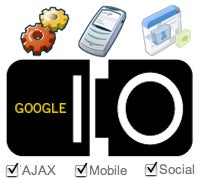 |
SAN FRANCISCO — Part of Google’s success is often credited to the speed and
simple design of its home page, which other search wannabes have copied.
But it turns out the design wasn’t the result of some great ‘less-is-more’
insight. The first Google home page with the simple search box was designed by
co-founder Sergey Brin.
“We didn’t have a Webmaster and Sergey said ‘I don’t
do HTML’ that’s why it’s [mostly] blank,” explained Marissa Mayer, Google’s
vice president of search products and user experience.
That bit of company lore drew a hearty laugh from the assembled crowd at this morning’s keynote for the day two wrap-up of the Google I/O developer conference
here.
Mayer zipped through several other quickie case histories of how
some other Google services evolved, and a common theme emerged; testing and
user feedback have been key to the company’s success.
Today, using the Google search box is a no-brainer for new and
experienced users alike. But when Google first tested the service nine years
ago at Stanford, Mayer said they were shocked at the result. Eight pairs of
testers were asked to launch the Google site and find the answer to the
question “Who won the most gold medals in the 1996 Olympics?”
Google was unknown at the time, but the expectation was that the utility
of the search box would have been obvious. Mayer recalled that after a minute of watching the testers stare at the screen, she asked what they were waiting
for. They all gave about the same reply: “We’re waiting for the rest of it,”
meaning the rest of the page to load. But of course, that’s all there was.
Google (NASDAQ: GOOG) has largely kept the spartan design. Mayer said she
believes in a twist on the Occam’s Razor theorem that “the simplest answer —
or simplest design — might be right.”
In fact, a simple suggestion by a member of her team later led to a
significant change in the design of Google’s iGoogle personalized home page
before its launch. “Enrique said, ‘Most users like the clean, classic look,
but some want more so we should do it,'” Mayer said. iGoogle ended up with
all sorts of personalization options and gadgets to fill up the screen based
on user preferences.
Mayer noted that many other ideas come from frequent brainstorming sessions,
where anything is open for discussion as the company tries to anticipate
what it needs to offer in two to five years and beyond.
“We think we’ll see a lot of different applications for search in phones
and cars,” she said. “And pages will be more like encyclopedias with
different types of images, videos and graphics.”
Mayer also said Google is debating and researching the best way to deliver more personalized results. “Maybe it will be based on what a person searched on last for improving relevance,” she said. “We don’t know what signals will matter most, but personalization is going to be important in the future.”
With its massively deep pockets, Google doesn’t lack for research tools
and manpower to create the next big service. But Mayer insisted the company
is largely made up of “scrappy” teams that are resource-constrained to help
drive innovation.
Google has become famous for making many of its services available free
in beta and even prebeta form as a way to gather user feedback, add
appropriate features and fix bugs. In addition to testing and feedback, metrics have been a key part of Google’s success,” Mayer said.
More is less, speed is all
She recalled that Google started giving 10 results per page to a search
query because that’s what AltaVista, an earlier, pioneering search engine,
did. But when surveyed, Google’s users said they wanted 30 results to a
page. Google tried it as an experiment but wasn’t happy with the outcome.
Inside of six weeks, the number of Google searches dropped by 20 percent.
Mayer said in looking at the logs, the company discovered that the thirty results were generally produced in a few seconds, but that was twice as long as the
one-second it took for 10 results. “Speed really matters,” Mayer said.
“We’ve found the same thing with Google Maps. If you make the process faster, you get more use right away.” Speed also affects the learning curve, she said.
“We look at the learning curve and aim for expert users,” she said. “We try
and understand where the user is likely to end up.”
Andrew Harris, a senior developer at ClickCommerce, was impressed by
Mayer’s presentation and a bit jealous. “They can test out a service with
millions of people at a time,” he said. “That’s amazing.”


